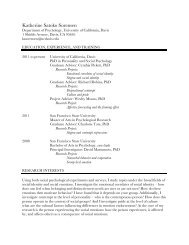The Psychology of Creativity:
The Psychology of Creativity:
The Psychology of Creativity:
You also want an ePaper? Increase the reach of your titles
YUMPU automatically turns print PDFs into web optimized ePapers that Google loves.
History <strong>of</strong> <strong>Creativity</strong> Research 8<br />
measurements, such as height or chest size, Quételet (1835/1986) showed that the variation in any physical trait<br />
could be described in terms <strong>of</strong> the normal, “bell-shaped” curve, or what is sometimes called the Gaussian<br />
distribution. <strong>The</strong> “average person” had a value on a trait that placed him or her at the center <strong>of</strong> the distribution,<br />
where the probability for that value was highest. Any departure from the mean became increasingly improbable to<br />
the degree <strong>of</strong> the departure, with the probabilities approaching zero in either direction. <strong>The</strong> normal distribution has<br />
now become such a integral part <strong>of</strong> psychology that the concept is discussed in virtually every introductory<br />
psychology textbook, and it provides the foundation for most <strong>of</strong> the statistical methods that psychologists use to<br />
study creativity or any other phenomenon. <strong>Creativity</strong> itself is <strong>of</strong>ten treated as if it were a normally distributed trait<br />
(Nicholls, 1972; cf. Simonton, 1999c). <strong>The</strong> person primarily responsible for this turn <strong>of</strong> events is Galton.<br />
Francis Galton. Trained as a mathematician, Galton began his career as a geographer and inventor who<br />
exhibited a remarkable predilection for quantification. Reading Darwin’s Origin inspired Galton to turn his<br />
attention to human behavior. Two implications were paramount in Galton’s mind. First, if Darwin’s evolutionary<br />
principles apply to Homo sapiens, then human beings must vary in the degree to which they are adapted to the<br />
environment. This led Galton to examine individual differences in human abilities. Second, for natural selection to<br />
work, adaptive traits must be passed down to <strong>of</strong>fspring. This motivated Galton to investigate the extent that<br />
individual differences were subject to biological inheritance. <strong>The</strong> first product <strong>of</strong> these new interests was a 1865<br />
magazine article titled “Hereditary Talent and Character.” Four years later this 20-page article was expanded into an<br />
extensive monograph that has become the first genuine classic in the history <strong>of</strong> creativity research: Hereditary<br />
Genius: An Inquiry into Its Laws and Consequences (Galton, 1869).<br />
Galton began by demonstrating that individuals vary immensely in what he styled “natural ability.” This<br />
was achieved by investigating the distribution <strong>of</strong> test scores. Significantly, not only were the individual differences<br />
substantial, but also the scores displayed a distribution that was closely approximated by Quételet’s normal curve.<br />
Galton then used the latter, theoretical definition to conceive <strong>of</strong> genius as someone whose natural ability places him<br />
or her at the extreme right portion (“tail”) <strong>of</strong> the bell-shaped curve. According to Galton, those with genius-level<br />
abilities would be so well adapted to the environment that they would necessarily attain eminence in any chosen<br />
domain, including those involving creativity. This tight causal connection between exceptional natural ability and<br />
achieved eminence provided the basis for his attempt to prove that natural ability was inherited. If the latter holds,<br />
then parents with genius-level in natural ability will have <strong>of</strong>fspring with comparable levels <strong>of</strong> natural ability, and so
















